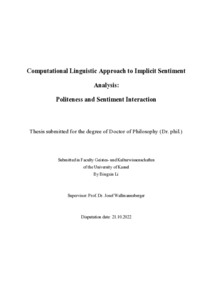| dc.date.accessioned | 2023-06-01T06:23:57Z | |
| dc.date.available | 2023-06-01T06:23:57Z | |
| dc.date.issued | 2022 | |
| dc.identifier | doi:10.17170/kobra-202305178038 | |
| dc.identifier.uri | http://hdl.handle.net/123456789/14781 | |
| dc.language.iso | eng | |
| dc.rights | Urheberrechtlich geschützt | |
| dc.rights.uri | https://rightsstatements.org/page/InC/1.0/ | |
| dc.subject.ddc | 004 | |
| dc.subject.ddc | 400 | |
| dc.title | Conputational Linguistic Approach to Implicit Sentiment Analysis: Politeness and Sentiment Interaction | eng |
| dc.type | Dissertation | |
| dcterms.abstract | Sentiment analysis is a hot topic in many research fields such as linguistics, computer science and marketing. With the development of technology, machines can reach very high performance on explicit sentiment analysis both sentence-level and aspect-level. The role of computational linguists has also changed from handcrafting scoring rules to guide training data annotation as the algorithms are developed from rule-based scoring to deep learning models that can extract language features themselves. Moreover, research on sentiment also goes deeper expanding to implicit sentiment analysis, mainly focusing on irony detection.
The research goal of this work is to find theories analyzing implicit sentiment in general, espeically the one affected by communication rules. The thoeries, politeness and converstional implicature, are selected from pragmatics, which aim to analyze language use in our daily life. Among these two theories, points that are related to sentiment are collected and illustrated with examples. Moreover, a politeness dataset is labeled with both explicit sentiment and implicit sentiment showing politeness and sentiment distributions for observing relation between these two concepts. Experiments with a transfer-learning architecture are conducted aiming to find whether if machine can extract shared features between politeness and sentiment. There are three source models in a Bi-LSTM+Attention structure for politeness, explicit sentiment and implicit senitment respectively and another three target models that combine features from source models. However, the results of the fine-tuning models had lower performance but the difference was not significant and within the range of human agreement. Moreover, Politeness classification task was the most difficult one regardless using transfer-learning techniques. Thus, the findings are that current machine cannot extract features from more subjective tasks; politeness and sentiment are related according to thoeries and data analysis. Experiments’ results did not reach better performance using transfer-learning architecture but still cannot reject the relevance between politeness and sentiment. Keywords: implicit sentiment analysis, politeness, conversational implicatures, transfer learning, deep learning. | eng |
| dcterms.accessRights | open access | |
| dcterms.creator | Li, Bingxin | |
| dcterms.dateAccepted | 2022-10-21 | |
| dcterms.extent | v, 286 Seiten | |
| dc.contributor.corporatename | Kassel, Universität Kassel, Fachbereich Geistes- und Kulturwissenschaften | |
| dc.contributor.referee | Wallmannsberger, Josef (Prof. Dr.) | |
| dc.subject.swd | Computerlinguistik | ger |
| dc.subject.swd | Computergestützte Kommunikation | ger |
| dc.subject.swd | Stimmung | ger |
| dc.subject.swd | Analyse | ger |
| dc.type.version | publishedVersion | |
| kup.iskup | false | |

